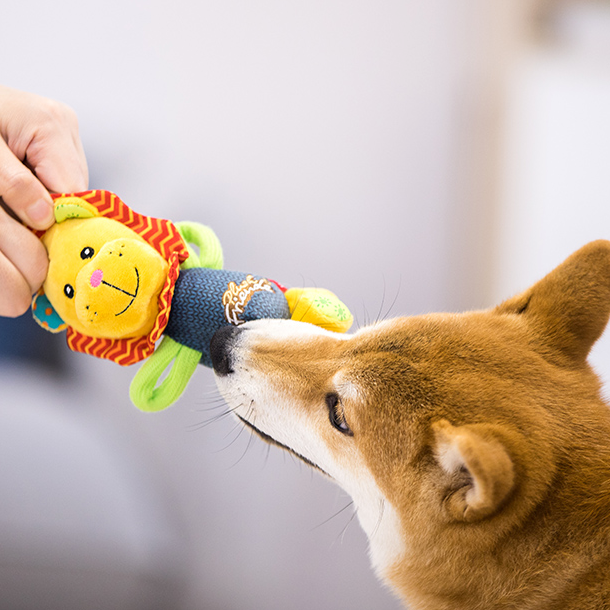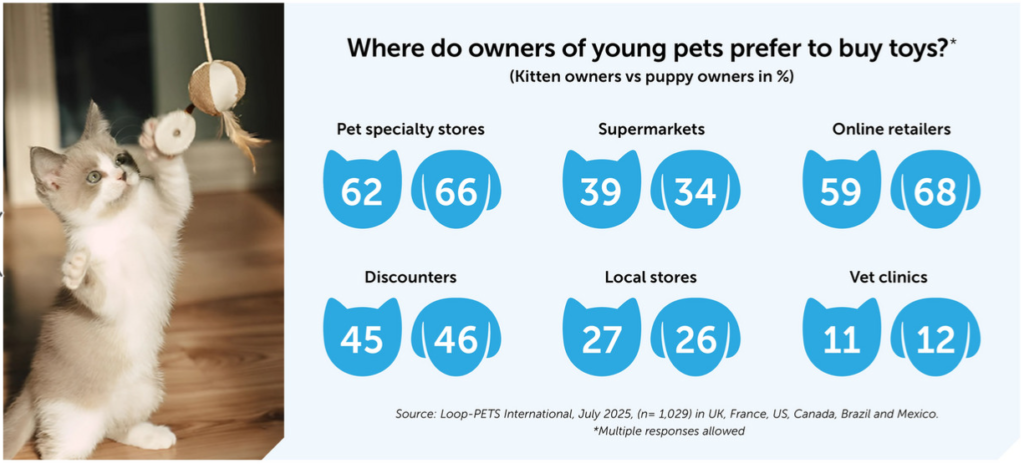
New consumer data is pulling back the curtain on how puppy and kitten owners shop for toys—and it’s full of insights for retailers and brands alike. Age, gender, location, and even pet age are all driving unique habits, from how often they buy toys to what factors influence their choices. Let’s break down what the latest survey (commissioned by PETS International and conducted by Loop) reveals.
Young Pets, Young Owners: Who’s Buying for Puppies & Kittens?
First, the demographic breakdown: Younger pet owners are far more likely to have puppies or kittens. The survey, which polled nearly 2,000 #petparents across the UK, France, the US, Canada, Brazil, and Mexico, found:
- Gen Z (18–28) has the highest rate of puppy and kitten ownership, with millennials (29–44) close behind.
- Older groups—Gen X and baby boomers—prefer adult or senior pets instead. This makes sense: Younger pets need more time, training, and playtime, which aligns better with the lifestyles of younger owners.
Globally, puppy owners outnumber kitten owners, especially in Canada and the US. And there’s a clear gender trend, too: 86% of puppy owners and 87% of kitten owners are women.
How Often Do They Buy Toys? Kitten Owners Lead the Pack
When it comes to toy-shopping frequency, kitten owners are the most active buyers:
- 25% of kitten owners have bought toys more than 6 times this year.
- Only 17% of puppy owners hit that 6+ purchase mark.
Compare that to owners of adult or senior pets: No more than 14% of them have bought toys 6+ times in 2025.
Another interesting shift? When you look at 2025’s first half vs. full-year 2024, puppy toy purchases seem to be dropping, while kitten toy buys are on the rise.

Spending Habits: Most Stick to Budget-Friendly Ranges
Price-wise, both puppy and kitten owners tend to keep things affordable:
- Last year, 75% of puppy owners and 66% of kitten owners spent up to $49 (€42) on #pettoys.
- The rest splurged on higher tiers: $50–$100 (€43–€86) or more.
Older pet owners are even more budget-focused: 95% of adult dog owners and 85% of senior cat owners stick to the under-$49 range.
Looking ahead 12 months, plans are mixed: 17% of puppy owners will spend less (vs. 14% spending more), while 21% of kitten owners will cut back (vs. 17% spending more).
Where Do They Shop? Online & Specialty Stores Win
Puppy and kitten owners have slightly different go-to shopping spots, but two channels stand out:
Puppy Owners’ Top Retailers
- Online retailers (Amazon, etc.): 68%
- Pet specialty stores: 66%
- Discounters (Target, Walmart): 46%
- Supermarkets: 34%
- Local/independent stores: 26%
- Vet clinics: 12%
Kitten Owners’ Top Retailers
- Pet specialty stores: 62% (their favorite!)
- Online retailers: 59%
- Discounters: 45%
- Supermarkets: 39%
- Local/independent stores: 27%
- Vet clinics: 11%
Older #petowners mix it up, too: Adult/senior cat owners shop online more (67–68%) than kitten owners, while adult/senior dog owners buy toys in supermarkets far more (51–63%) than puppy owners.
What Influences Their Choices? Safety, Price, and Trust
When picking a toy, puppy, and kitten owners prioritize two things above all:
- Safety: 71% of puppy owners and 72% of kitten owners list this as top.
- Price: 69% of puppy owners and 73% of kitten owners care most about cost.
Beyond that, product reviews are their most trusted source of info—followed by packaging/design, peer recommendations, and social media. But here’s a key stat: Over a third of them don’t stick to any single brand. They buy based on what’s available and how much it costs.
Material-wise, rope toys are a hit: 60% of puppy owners and 65% of kitten owners prefer them. Fabric toys (64% and 59%) and eco-friendly options (56% and 57%) are popular, too.
Safety First: Toys They Avoid (and Why)
To keep their young pets safe, owners steer clear of certain toys:
- Laser toys: 28% of puppy owners and 33% of kitten owners avoid them.
- String toys: 24% of puppy owners and 21% of kitten owners skip them.
- Feather toys: 20% of puppy owners and 21% of kitten owners say no.
Their biggest worries? Choking hazards (76–80%), risk of ingesting small parts (76–78%), and sharp components (56–62%).
Why Toys Matter: More Than Just Play
Owners know toys do more than entertain—they support their pets’ health:
- Relieve boredom: 92% of puppy owners and 89% of kitten owners say this.
- Encourage exercise: 88% of puppy owners and 86% of kitten owners agree.
- Boost mental stimulation: 74% of puppy owners and 77% of kitten owners see this benefit.
Toys also solve common pet challenges: They ease separation anxiety (39% for puppies, 47% for kittens), redirect destructive behavior (47% for puppies, 61% for kittens), and even support dental health through safe chewing (27% for puppies, 30% for kittens).
For brands and retailers, these trends boil down to one simple truth: To win over puppy and kitten owners, focus on safety, affordability, and convenience. Whether they’re shopping online or in a specialty store, they want toys that keep their young pets happy and healthy—without breaking the bank.
Source: GlobalPETS
